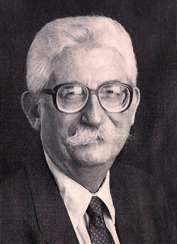Richard Remington, PhD
1931 — 1992

Professor Remington, educator, administrator, and statistician, was born in Idaho and educated in Montana and at the University of Michigan. At a young age he survived malignant hypertension as one of the earlier successes of the Smithwick total sympathectomy procedure, which conditioned his lifelong research interest in hypertension.
Remington received the CIBA award for hypertension research in 1980 for the design and implementation of the Hypertension Detection and Follow-up Program, including the sample size estimation which gave the trial power to demonstrate an effect on mortality in the whole community. (1) It was a study well-governed, well-conducted, and well-concluded with a distinguished publication that became central to the future of the control of hypertension.
He was centrally involved in the design of the first Multiple Risk Factor Intervention Trial (MRFIT) in collaboration with Henry Taylor and Jeremiah Stamler in the late 1960s. (2) The elegance, simplicity, and power of that design were unfortunately not employed by the NIH designers of the eventually-funded contractual MRFIT trial. Nevertheless, his contribution is importantly responsible for the development of the Multiple Risk Factor concept.
Remington made seminal contributions to understanding of causation and proof in distinguished essays and lectures pointing up the relative weakness of current concepts of cause and proof, the unobtainability of experimental proof in many areas that touch on the public health, and the development of rational decision-making for public health policy in the absence of “final proof.”
Remington was successively professor, dean, and provost at Michigan, Texas Houston, and Iowa, where he vastly strengthened each institution by firm and principled leadership. His leadership was influential as well in American Heart Association policy and in the Institute of Medicine’s major 1980s report on the status of education for public health. (3)
He delighted his colleagues particularly with his lectures on causality, his good stories, and many great performances on bass horn in jazz groups for international scientific conferences. He saddened them by his premature demise from cancer. (HB)
Sources
Oral history with Richard Shekelle, April 17, 1989.
1) Davis BR, Ford CE, Remington RD, Stamler R, Hawkins CM. (1986). The Hypertension Detection and Follow-up Program design, methods, and baseline characteristics and blood pressure response of the study population. Prog Cardiovasc Dis, 29(3 Suppl 1), 11-28.
2) Taylor HL, Buskirk ER, Remington RD. (1973). Exercise in controlled trials of the prevention of coronary heart disease. Fed Proc, 32(5), 1623-7.
3) Remington RD. (1989). Is public health in the United States in disarray? Am J Prev Med, 5(3), 125-6.
Related Content
Audio Clips
Essays
- Panel On Causation
- A Transition from the Early to the Modern Era of CVD Epidemiology: ‘The Pause,’ 1968 to 1972